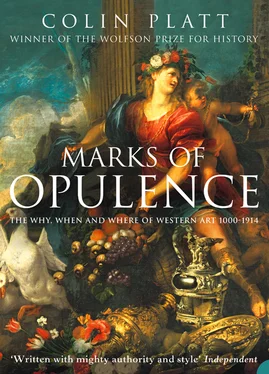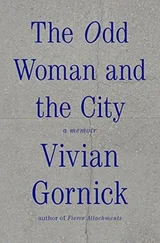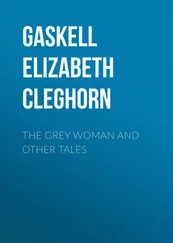That quality was the more welcome for following the long contraction which Professor R.S. Lopez was the first to identify as ‘the economic depression of the Renaissance’. 35 Every part of Europe was affected by it. Fertile, mild of climate, and well-situated for the London market, Kent is still commonly known as England’s ‘Garden’. Yet even in this most favoured location of middle-income yeoman farmers, new housing-starts fell off appreciably in the mid-fifteenth century, to recover again only in the 1470s. 36 Nor can it be doubted that a currency crisis so prolonged and so severe as simultaneously to threaten Medici solvency and close the Flemish mints must have brought many larger projects to an end. That the crisis was less punishing to the arts than to the economy in general was owed to a combination of special circumstances: to mortalities so unremitting as to destroy individual families and bring fortunes together, to paranoid investment in soul-care provision, and to a culture of ‘magnificence’ and free-spending. Another contributory circumstance was civil war.
One prominent casualty of the depression was the Malatesta principality of Rimini. And there, towards the end of 1461, with his city half-empty and nothing left to tax, Sigismondo Malatesta found himself unable to keep the literati in his household or pay his artists. Even work on his half-finished tomb-church of San Francesco – Alberti’s Tempio Malatestiano at Rimini – would have to stop, and the only remedy left to him was war. 37 On this occasion, Sigismondo’s enemy was Pius II, whose hired captain in the field was the Malatesta’s next-door neighbour at Urbino. And two years later, it would be Federigo da Montefeltro’s decisive victory over Sigismondo and his mercenaries that almost trebled Urbino’s territory, raising its lord – already the most famous condottiere of his day – to the wealth and magnificence of a prince. Duke Federigo (1420–82), a ‘Mars in the field, a Minerva in his administration’, typifies the century’s virtues and its vices. But what his history makes quite clear is that there was no way for a fifteenth-century nobleman, however sophisticated his education or spreading his estates, to prosper on good government alone. Federigo was a poor man when he came by chance into his inheritance. It was the vendetta, essentially, that made him wealthy. With as much blood on his hands as any Mafia godfather, Federigo’s ambition to rebuild his Urbino palace was status-driven: ‘to make in our city of Urbino a beautiful residence worthy of the rank and fame of our ancestors and our own status’.
Where Federigo differed from most other captains of his day was in his schooling. He had begun his education at the Mantuan academy of the great humanist teacher Vittorino Rambaldoni da Feltre (d.1446). And his favourite reading in later life remained the usual humanist texts, with a particular professional preference for the histories of Livy and for the De Bello Gallico of Julius Caesar. ‘In arms, his first profession’, recollected Vespasiano, who had sold him many books, ‘he was the most active leader of his time, combining strength with the most consummate prudence, and triumphing less by his sword than by his wit.’ 38 And in truth, the bookseller reasoned, ‘it is difficult for a leader [today] to excel in arms unless he be, like the Duke, a man of letters, seeing that the past is a mirror of the present’. More followed:
As to architecture it may be said that no one of his age, high or low, knew it so thoroughly. We may see in the buildings he [Federigo] constructed, the grand style and the due measurement and proportion, especially in his palace, which has no superior among the buildings of the time, none so well considered, or so full of fine things … As to sculpture he had great knowledge … employing the first masters of the time. To hear him talk of sculpture you would deem it was his own art. He was [also] much interested in painting, and because he could not find in Italy painters in oil to suit his taste he sent to Flanders and brought thence a master [Joos van Gent] who did at Urbino many very stately pictures, especially in Federigo’s study, where were represented philosophers, poets, and doctors of the Church, rendered with wondrous art. He painted from life a portrait of the Duke which only wanted breath. 39
That portrait was long thought to have been the formal double-portrait of Federigo da Montefeltro and Guidobaldo, his infant son, now more usually attributed to Pedro Berruguete, the Castilian. And the long-term presence at Federigo’s court of two such major foreign artists, while saying something also about their own crisis times at home, is tribute enough already to the range and intelligence of the duke’s patronage. But the portrait has other intentions. Its first and most obvious emphasis is on the duke’s worldly success and magnificence. Duke Federigo displays his chivalric honours: the Garter of England and the Ermine of Naples. The great book he is holding is bound in the distinctive scarlet livery of what he had always intended from the first to be ‘the finest library since ancient times … bought without regard of cost’. A richly dressed Guidobaldo, at his father’s knee, holds the sceptre of government and promises the continuity in the Montefeltro dynasty which is the second major message of the painting. That continuity had not been easily achieved. Federigo himself had been born illegitimate. He had succeeded his murdered half-brother at Urbino chiefly because the much younger Oddantonio had no son. Then two of Federigo’s own natural sons – the talented Buonconte and probably Bernardino also – had died of the plague; while the pale and delicate Guidobaldo of the Urbino double-portrait was the cradle-sick last child of what was otherwise a quiverful of daughters.
Berruguete’s painting is not overtly religious. It lacks even the usual close attendance of a saint. Yet we are told that ‘as to works of alms and piety he [Federigo] was most observant. He distributed in his house every day a good quantity of bread and wine without fail, and he gave freely to learned men and gentlefolk, to holy places, and to poor folk ashamed of their case.’ 40 Federigo’s charity, we may assume, had some design. There is another and larger painting at Urbino, more certainly by Joos van Gent, in which the duke is shown with members of his circle as witnesses of Our Lord at the Last Supper. The Communion of the Apostles (1473–4) is the central panel of a big and costly altarpiece, partly paid for by the duke but commissioned for their chantry by one of the wealthier confraternities of Urbino. Its purpose, unequivocally, was commemoration. Not many years before, Niccolò della Tuccia, similarly portrayed with the Madonna of Mercy (1458) at Viterbo, had sought to justify his presence in that company. He was there, Niccolò explained, ‘not out of pride or vainglory, but only in case any of my successors wishes to see me, he can remember me better thus, and my soul may be commended to him ’. 41 In Renaissance Italy, as throughout the Gothic North, neither the banker nor the soldier, the priest nor the scholar could ever entirely set aside their apprehensions. Art has never known a greater stimulus than fears of Purgatory.
CHAPTER FOUR Expectations Raised and Dashed
‘Money is like muck’, wrote Francis Bacon (1561–1626), ‘not good except it be spread.’ And in his own lifetime there was much more of it about. In complete contrast to the severe and prolonged bullion famines of the late fourteenth and fifteenth centuries, Central European silver production had enormously increased. The formerly rich but long abandoned silver sources at Goslar, Freiberg and Kutná Hora had been made accessible again by more up-to-date technologies. And the new silver mines at Schneeberg (Saxony) and Schwaz (the Tirol) had come into full production by the 1470s, to be closely followed in the next generation by those at Annaberg (Saxony) and Joachimsthal (Bohemia). 1 In 1542, in the first known formulation of the quantity theory of money (according to which price levels are determined by the money supply), Sigismund of Poland’s counsellors reported: ‘This year the unmeasurable increase of the coinage has raised the value of the gulden very much and will raise it still further, if nothing is done … When now the gulden (which is a measure and standard of everything bought and sold) rises and becomes dearer, it follows that everything brought from abroad and grown at home must become dearer too.’ 2 ‘As for the reason [for these price rises]’, wrote Peter Kmtia, Palatine of Cracow, that same year, ‘nobody is so foolish as not to see that the multitude of coins is to blame, which is in no relation to either the gulden or the things to be bought, as it used to be in former times.’ 3
Читать дальше












